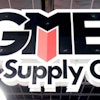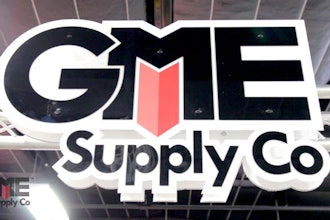
Infor
Life in the fast lane
How distributors can accelerate
the pace of profitability
It’s no secret that your
world is changing
Your industry has gone global, has become more competitive than ever, and has
grown increasingly sophisticated. The next generation of distributors has arrived,
and is quickly adopting innovative technologies to optimize daily operations and
hone their competitive edge.
The rise of social collaboration, the explosive adoption of mobile devices, and
other technological trends are reshaping the distribution industry. Your vendors,
customers, and employees now expect to work the way they live, with access
to information from any place at any time.
The steady pace of the previous era is gone. Like it or not, you’re now in the
fast lane of a rapidly evolving industry.
In this ebook, we’ll explore ways that you can streamline, automate, and
modernize your business—and do it faster and smarter than anyone else.
Visit our Distribution
industry site to learn
more about automating,
streamlining, and
modernizing your day to
improve profitability and
long-term success.
2
Developing intelligent
inventory management
What if you could solve the perennial puzzles of dead stock, orphaned non-stocks, and
other daily challenges that make it so difficult to strike the essential balance between
turns and fill rates?
A process known as Advanced Inventory Management (AIM) holds the key. By using
data-driven technology to provide more comprehensive inventory management
capabilities, AIM can help you:
• More accurately predict demand
to improve restocking efficiency.
• Better manage transfers among
multiple locations.
• Reduce errors and maintain
appropriate levels of physical inventory.
• More effectively manage costs.
Working smarter is the key. AIM can help you streamline your inventory
management processes and reduce costs associated with freight, transactions,
and errors, so you can maximize profitability. Inventory is your biggest asset, and
managing it effectively is the key to increasing profitability, as well as creating
happy customers.
“
AIM allows the company to
drive fill rates, turns, and better
profits with less work—by
working smarter. Instead of
your people spending 80% of
their time chasing and putting
out fires, they’ll spend 80%
of their time managing your
inventory and delivering a
great customer experience and
inventory ROI.”
GRANT W. HOWARD
Inventory Management
Thought Leader & Principal,
Grant W. Howard Company
See how Grant W. Howard advises
organizations how they can work
smarter with AIM
3
Changing the nature
of the distributor-
customer relationship
Imagine a scenario where you could replenish the inventory in your customer’s
warehouse without them even having to place an order. That’s the idea behind
distributor-managed inventory, a practice that forward thinking distributors are using
to differentiate themselves and forge closer bonds with their most valuable customers.
Functioning more like an ever-present, intelligent partner, you can manage and replace
materials in your customers’ toolcrib, industrial vending machines, repair supplies, and
operations inventory. Replenishment is managed behind the scenes so your customer
always has what they need, when they need it—without having to place an order.
A more efficient workflow for them means a more satisfied, loyal customer for you.
“
As wholesale distributors look
for new ways to differentiate
themselves in the market, some
are discovering that investing
in an integrated supply model
can be a creative and profitable
way to re-engineer their
customer relationships.”
SIMON ELLIS
Program VP
IDC Manufacturing Insights
Read the press release
Innovate, integrate
A growing distributor relies on integrated
supply and other innovations to break out
of the traditional distributor box.
Read the Turtle & Hughes: Industrial Distribution cover story
4
Enhancing end-to-end efficiency
for better margins
Low margins are an ever-present threat to profitability. In a complex distribution environment, managing margins requires improving
day-to-day operational efficiencies, lowering costs, setting prices more intelligently, and tracking down any profitability leaks.
Today’s innovative distributors are implementing software solutions that give them a holistic view of their day-to-day operations and
margins, and are exploring a cloud-based infrastructure to improve efficiencies and reduce overall costs.
“Because wholesalers operate on slim margins . . . the industry is always looking for ways to create efficiencies and cut costs.
The cloud gives organizations an opportunity to reevaluate the existing IT hardware spend as well as the IT department’s role.
Wholesalers can also use the cloud as an opportunity to improve current IT staff productivity and end-user service levels by
reallocating IT staff to work on more strategic internal initiatives without adding new, expensive resources.” 1
Take to the cloud to improve margins
5
Bringing modern
analytics to an
age-old problem
Setting the right price is a headache for any business. But your retail
and manufacturing counterparts don’t have to contend with the enormous
transaction volume, high SKU counts, disparate units of measure, and
other pricing complexities that are all too familiar to distributors.
That’s why software built specifically for the distribution industry is so
critical—it provides the visibility and agility you need to:
Maximize your margins by offering different pricing options, including
velocity pricing, contract pricing, quantity breaks, and promotions.
Get a global view of stock inventories to accurately quote prices on
the fly (and quickly convert quotes to orders).
Evaluate what-if scenarios to better understand the impact of potential
price adjustments.
Rebates, charge backs, credits, and
other special pricing authorizations
can mean a bump in revenue. But
many distributors risk leaving this
money on the table because they
use a manual process for tracking,
monitoring, and reporting.
Tracking inventory as it’s sold and
setting up automatic notifications
so you know when it’s time to
submit rebate claims means faster
rebate recovery and better margins.
Technology built specifically for a
distributor’s needs can help you
automate this process so it’s done
correctly every time.
Rethinking the
rebate process
6
Giving the people
what they want
Value-added services certainly aren’t new. But
competition is heating up, that’s why it’s more
important than ever for you to offer your customers
something that sets you apart.
Building loyalty and carving out your own niche in an increasingly
competitive landscape means finding creative ways to provide additional
services that can grow revenue and win new business. The good news is
that modern software applications are making it easier for distributors to
integrate value added services like light manufacturing, assembly, private
labeling and others.
Service + ease-of-use = happy customers
To augment its core distribution business,
Huttig Building Products also builds custom
doors for its customers. Using a product
configurator, Huttig customers can log in
and create the door they need. The
online tool also lets them access pricing,
automatically mark it up, email a quote to
the end customer, and purchase the
door with a click of a button.
Watch the video to see how Huttig
incorporates light manufacturing and
an online self-service tool to improve
its margins and build customer loyalty.
7
Learning to love
social collaboration
You might think the term “social media” is synonymous with wasted time—
especially when it comes to running a successful company. But now social
media’s influence floods the business world, and tech savvy leaders know social
collaboration saves time and improves communication.
Relying on email, instant messaging, online meetings, and conference calls
means critical information is spread out and hard to find when you need it.
To bring all of this vital information into one shared space that’s easily searchable,
social collaboration applications borrow features from familiar sites like
Facebook® and Twitter®.
Employees can save time and get tasks done more efficiently by following
people, documents, and projects. The true value of social collaboration is when
companies, through broader adoption, go beyond improved communication to
operational efficiency.
• Increase productivity
• Capture corporate knowledge
• Improve decision making
• Attract and retain top talent.
Social collaboration helps you:
Watch how leading HVAC distributor Mingledorff’s deployed tools for social
collaboration with virtually no training. Within two days their employees were
creating groups and sharing files.
8
Taking your act
on the road
It’s certainly not news that most companies rely on mobile devices to connect and
collaborate. More and more distributors are shifting some of their IT budgets to mobility
and opening up their core business applications to workers on the go. For example,
according to the Aberdeen Group, best-in-class wholesalers and distributors are 90%
more likely to provide users with mobile access to their ERP system.2 Mobile access
allows you to:
Empower your employees to work smarter. By giving them fulltime access to core
business applications, “down time” can turn into productive time.
Satisfy your customers with self-service options and the information they need to
track orders, ask questions, and run their own businesses more efficiently.
Attract the next generation of employees who expect employers to offer a digital
culture that embraces BYOD.
Whether it’s a sales rep who needs to update invoices in real time, a customer who
wants to track an order, or a procurement specialist who needs to modify a PO on
the fly, integrating mobile devices with your core software can help you work smarter
(and faster) than your competitors.
For the forward-looking
wholesaler, leveraging mobile
tools for improving service
levels, transmitting orders, and
managing customer product
orders or configurations can
be a way to drive incremental
sales and profits. 3
9
On average, On average,
Embracing the
distribution evolution
Years ago, distributors may have been slower to adopt new technologies.
But the industry is now evolving quickly, and a new generation of owners
and managers expect to benefit from powerful, easy-to-use software and
applications in the workplace.
As analyst Cindy Jutras points out, this new generation of owners “doesn’t
understand why the apps they inherited with the business aren’t as easy to
use as the ones they use on their smartphones and tablets.” 4
Similar expectations are also affecting the ability to recruit and hire the best and
brightest. Companies are seeking technologically savvy employees who can
help them innovate. However, attracting these talented workers means creating
a culture built on technology. As “digital natives,” they expect mobile, social,
cloud, and intuitive apps to be the norm.
Whether it’s hiring the best employees, offering new services, or making daily
operations more efficient, technology is playing a significant role in the evolution
of the industry. Companies that can’t find a way to integrate these innovations will
find their daily lives more chaotic and their ability to compete severely hampered.
But for those distributors that can embrace the distribution evolution, technology
can mean that life in the fast lane is a smooth ride.
“
Since this age group has
been weaned on emerging
technology from the time they
were children, they expect
the tools that their employers
provide to be easy to use,
attractive, and to mirror the
technology that they use
outside of work.” 2
NICK CASTELLINA
Research Director
Business Planning and Execution
Aberdeen Group
10
About Infor
Infor builds beautiful business applications with last mile functionality and scientific insights delivered as a cloud
service. With 13,000 employees and customers in more than 200 countries and territories, Infor automates critical
processes and helps eliminate the need for customization through embedded industry domain expertise.
To learn more, visit www.infor.com.
References
1 IDC Retail Insights–Technology spotlight: Opportunities for the modern wholesale distributor to leverage technology and leapfrog the competition
2 Aberdeen Group, “Embracing Change in Wholesale and Distribution: Who (or What) Is Your Change Agent?” Nick Castellina, September 2014
3 IDC Technology Spotlight: Opportunities for the modern wholesale distributor to leverage technology and leapfrog the competition
4 Mint Jutras, “Can ERP Help Bridge the Generational Divide in Wholesale Distribution?” August 2014
Disclaimer
This document reflects the direction Infor may take with regard to the specific product(s) described in this document, all of which is subject to change by Infor
in its sole discretion, with or without notice to you. This document in not a commitment to you in any way and you should not rely on this document or any of
its content in making any decision. Infor is not committing to develop or deliver any specified enhancement, upgrade, product, or functionality, even if such is
described in this document.
Copyright © 2016 Infor. All rights reserved. The work and design marks set forth herein are trademarks and/or registered trademarks of Infor and/or related
affiliates and subsidiaries. All other trademarks listed herein are the property of their respective owners.
Part INFDTP1483164-en-US-0216-1
11






















